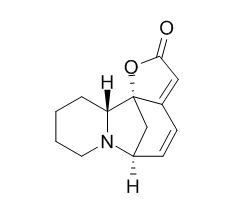Viroallosecurinine
Virosecurinine and viroallosecurinine were isolated as two cytotoxic alkaloids from the leaves of Securinega virosa. Viroallosecurinine exhibits a MIC of 0.48 micrograms/ml for Pseudomonas aeruginosa and Staphylococcus aureus.
Inquire / Order:
manager@chemfaces.com
Technical Inquiries:
service@chemfaces.com
Tel:
+86-27-84237783
Fax:
+86-27-84254680
Address:
1 Building, No. 83, CheCheng Rd., Wuhan Economic and Technological Development Zone, Wuhan, Hubei 430056, PRC
Providing storage is as stated on the product vial and the vial is kept tightly sealed, the product can be stored for up to
24 months(2-8C).
Wherever possible, you should prepare and use solutions on the same day. However, if you need to make up stock solutions in advance, we recommend that you store the solution as aliquots in tightly sealed vials at -20C. Generally, these will be useable for up to two weeks. Before use, and prior to opening the vial we recommend that you allow your product to equilibrate to room temperature for at least 1 hour.
Need more advice on solubility, usage and handling? Please email to: service@chemfaces.com
The packaging of the product may have turned upside down during transportation, resulting in the natural compounds adhering to the neck or cap of the vial. take the vial out of its packaging and gently shake to let the compounds fall to the bottom of the vial. for liquid products, centrifuge at 200-500 RPM to gather the liquid at the bottom of the vial. try to avoid loss or contamination during handling.
Biochem Biophys Res Commun.2021, 534:802-807.
Planta Med.2018, 84(15):1101-1109
Molecules.2023, 28(2):727.
Chemistry of Plant Raw Materials2019, 4:135-147
Kaohsiung J Med Sci.2024, 40(3):280-290.
Planta Med.2024, 2328-2750
PLoS One.2017, 12(3):e0173585
Pharmaceuticals (Basel).2024, 17(1):108.
Separations2023, 10(2), 131.
Int J Mol Sci.2023, 24(8):7300.
Related and Featured Products
Nat Prod Res. 2007 Mar;21(3):234-42.
Callus of Securinega suffruticosa, a cell line accumulates dextro Securinega alkaloids.[Pubmed:
17365714 ]
Investigations on callus cultures of Securinega suffruticosa indicated that the cell line of S. suffruticosa callus was able to accumulate four known Securinega alkaloids with dextro rotation but not levo rotation as reported before: virosecurinine (1), Viroallosecurinine (2), 14,15-dihydrovirosecurinine (3) and ent-phyllanthidine (4). Time course studies on the growth of callus cultures were carried out. The effects of different plant growth regulators, sucrose concentrations on callus growth and virosecurinine production were also reported.
J Ethnopharmacol. 1990 Feb;28(1):129-33.
Antibacterial activity of the leaves of Phyllanthus discoideus.[Pubmed:
2156112]
The lyophilized aqueous extract (LWE) from the leaves of Phyllanthus discoideus was found to show an antibacterial activity.
METHODS AND RESULTS:
The alkaloid fraction obtained from LWE inhibited the growth of Escherichia coli and Enterococcus faecium (MIC = 1.6 mg/ml), Pseudomonas aeruginosa (MIC = 0.78 mg/ml), Staphylococcus aureus and Mycobacterium smegmatis (MIC = 0.2 mg/ml). Among the alkaloids identified, Viroallosecurinine and securinine showed a high activity. Viroallosecurinine exhibited a MIC of 0.48 micrograms/ml for Ps. aeruginosa and Staph. aureus.
CONCLUSIONS:
This alkaloid is bactericidal since the yields of MIC/MBC were less than 1. The MIC of securinine was 0.500 mg/ml for E. coli, Staph. aureus and Myc. smegmatis. These effects of Phyllanthus discoideus leaf extracts support some of the local uses of the plant in traditional therapy.
J Pharm Sci. 1991 Apr;80(4):325-7.
Cytotoxic principles of Securinega virosa: virosecurinine and viroallosecurinine and related derivatives.[Pubmed:
1865332]
Virosecurinine (1) and Viroallosecurinine (2) were isolated as two cytotoxic alkaloids from the leaves of Securinega virosa. A comparison of the cytotoxicity of 1 and several of its derivatives indicates that an alpha,beta- and a gamma,delta-unsaturated lactone located in a strained ring system, such as rings -B, -C, and -D of 1, is structurally required for significant cytotoxicity.



